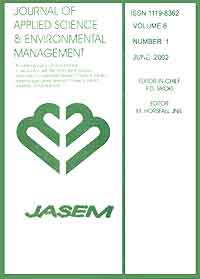
|
Journal of Applied Sciences and Environmental Management
World Bank assisted National Agricultural Research Project (NARP) - University of Port Harcourt
ISSN: 1119-8362
Vol. 14, No. 1, 2010, pp. 63-65
|
 Bioline Code: ja10011
Bioline Code: ja10011
Full paper language: English
Document type: Research Article
Document available free of charge
|
|
|
Journal of Applied Sciences and Environmental Management, Vol. 14, No. 1, 2010, pp. 63-65
| en |
Investigation of Corrosion of Buried Oil Pipeline by the Electrical Geophysical Methods
Ekine, A. S. & Emujakporue, G. O.
Abstract
The delineation of possible areas of corrosion along an underground oil pipeline in Ubeji, Delta State, Nigeria was investigated using the horizontal electrical resistivity profiling technique and the Spontaneous Potential geophysical method. The resistivity and self potential values of the soil along the pipeline were obtained using the R-plus resistivity meter. The results show that areas of low resistivity, having values between 98.0 and 116.0 Ohm-m, coincide with areas of high negative spontaneous potential values, in the range -31.0 to -52 mV. The low apparent resistivity and high negative spontaneous potential values are indications that the soil is very corrosive and there is the possibility of the pipeline failure and oil spillage around these hot spots in the future. These methods applied in the study are quick, economic and efficient for detecting likely anodic hot spots along buried pipelines which need to be protected. Routine electrical geophysical investigations along buried oil pipelines should be undertaken for the early detection and prevention of pipeline failure with its attendant environmental, human and economic consequences. @ JASEM
|
| |
© Copyright 2010 - Journal of Applied Sciences & Environmental Management
|
|
